Legio X Gemina
Legio X Gemina: one of the Roman legions. Its name means "the twin legion".
Origin

With the Seventh, Eighth, and Ninth legions, the Tenth was among the oldest units of the imperial Roman army. They were with Julius Caesar when he invaded Gaul in 58 BCE and the Roman commander mentions the Tenth Legion in his accounts of an encounter with the Germanic leader Ariovistus (where Caesar states that he always trusted this unit completely). The soldiers of the Tenth are also mentioned in the battle against the Nervians in 57 (where they saved the day), the invasion of Britain in the summer of 55 (where the standard bearer of the Tenth played a heroic role), and the siege of Gergovia in 52. The soldiers must have taken part in many other engagements as well. It is possible that the Tenth Legion was already called Equestris ("mounted"), because Caesar describes how he employed the soldiers as cavalry.
In the civil war against Caesar's fellow-triumvir Pompey, the Tenth fought in Hispania in the battle of Ilerda (summer 49). In the spring of 48, the soldiers of this unit served at Dyrrhachium. It was present in the battle of Pharsalus (9 August 48), and although the soldiers were sent back to Italy after the battle to be pensioned off, they also participated in Caesar's African campaign in 46. Finally, the Tenth Legion was present at Munda in Andalusia (17 March 45). On their way back, the veterans finally received land at Narbo Martius in southern Gaul.
On 15 March 44, Caesar was assassinated and a new civil war broke out. In the first round, Caesar's relative Octavian demanded a share in the leadership of the Caesarian party, in the second round Octavian, Mark Antony, and Lepidus (the Second Triumvirate) attacked the assassins, Brutus and Cassius. To this end, the Tenth Legion Equestris was reconstituted by Lepidus (in the winter of 44/43).
In 42, the refounded Tenth fought for the triumvirs in the battle of Philippi, where the opponents of the Caesarian party were defeated. After their victory, veterans were settled at Cremona in northern Italy.
The Tenth was now transferred to the East and participated in Mark Antony's war against the Parthian Empire and his invasion of Armenia (36-34). In these years, the relations between Octavian and Mark Antony deteriorated, and this culminated in Antony's ill-fated Actium campaign (31), where Octavian defeated his fellow-triumvir. The Tenth Legion was among the troops that surrendered to the new sole ruler of the empire.
Spain
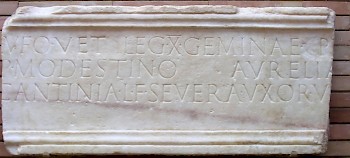
Octavian settled veterans at Patras. However, the Tenth revolted and was punished: it lost its prestigious name Equestris. Veterans from other legions were added to the unit, and it was from now on called X Gemina ("the twin legion"). Octavian, now known as the emperor Augustus, sent the Tenth to Petavonium in Hispania Tarraconensis (modern Rosinos de Vidriales).
The legion took part in Augustus' campaigns against the Cantabrians, which lasted from 25-13 BCE and were intended to make the Ocean the frontier of the empire. This was a very large war: among the other troops involved were I Germanica, II Augusta, IIII Macedonica, V Alaudae, VI Victrix (which seems to have shared its base, perhaps near Braga, with our unit), VIIII Hispana, XX Valeria Victrix, and another legion, perhaps VIII Augusta. Soldiers of this unit and VI Victrix were among the first settlers of Mérida, Cordoba, and Zaragoza.
Up and down to Carnuntum
After a stay of almost a century in Hispania Tarraconensis, the Tenth "twin" Legion was sent to Carnuntum in Pannonia, a bit east of modern Vienna. The precise year of the transfer is not known, but 63 (or a bit earlier) is a good guess, because in that year, XV Apollinaris left Carnuntum and went to the east to fight in Corbulo's war against the Parthians.
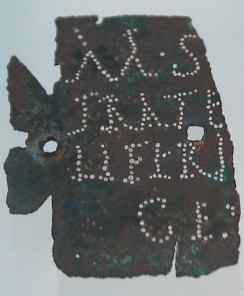
During the brief reign of the emperor Galba (68-69), the Tenth was transferred back to Hispania - something the soldiers must have appreciated. A recently created legion, VII Galbiana, was to be the new garrison of Carnuntum.
Nijmegen
However, the Tenth' stay in Hispania was to be very brief. In 70, the new emperor Vespasian sent his relative Quintus Petillius Cerialis to the Rhineland to suppress the rebellious Batavians. Immediately after their arrival in the province of Germania Inferior, the soldiers of the Tenth Legion had to defend themselves against enemy attacks at Arenacum (Kleve), where they had their winter quarters. They were successful.
After they had restored order, they were ordered to garrison the Hunerberg, a hilltop east of Noviomagus (modern Nijmegen). Here, they guarded the Batavians. The soldiers of the Tenth must have hated the cold and wet country of the Lower Rhine that was to remain their home for a generation.
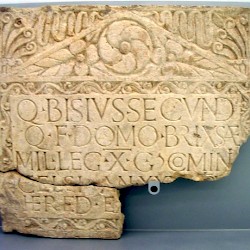 Nijmegen, Inscription of Bisius of X Gemina |
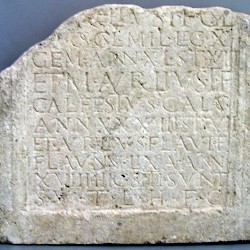 Nijmegen, Inscription mentioning three relatives in X Gemina |
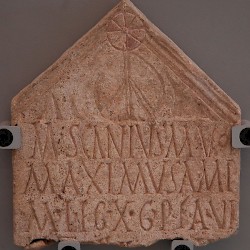 Nijmegen, Tombstone of Scanius of X Gemina |
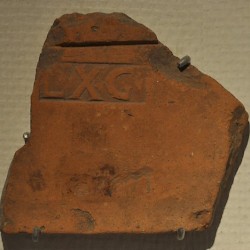 Voorburg, Rooftile with the sign X Gemina |
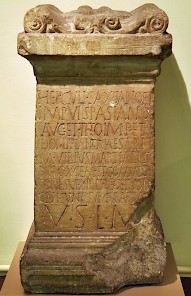
The fortress on the Hunerberg (which has partly been excavated) is not the only archaeological site connected to X Gemina. A country estate near Nijmegen called De Holdeurn was once the location of a large production center of tiles and pottery. There was also a sanctuary dedicated to the supreme god Jupiter, to Vesta, and to a local goddess named Hludana. The factory was to continue its production after the legion had left.
A similar production center was situated at an unknown site across the Rhine. Soldiers of the Tenth were also employed in a stone quarry in the valley of the Moselle, which was far outside the province of Germania Inferior. Several inscriptions attest that soldiers were active in Voorburg, Neuss, Gellep, and nearby Xanten, but the evidence is meager.
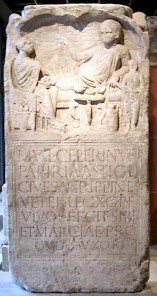
When in 89 the governor of Germania Superior, Lucius Antonius Saturninus, revolted against the emperor Domitian, the army of Germania Inferior (I Minervia, VI Victrix, X Gemina, XXII Primigenia) hurried to the south, to Mainz, and defeated the rebel. Every legion was awarded the title Pia Fidelis Domitiana ("faithful and loyal to Domitian"). The last part of this honorific title was dropped when this emperor was murdered in 96.
He was succeeded by an old senator named Nerva, who appointed the governor of Germania Inferior, Trajan, as his successor. He was in Cologne when he heard the news of Nerva's death (98), but did not return to Rome immediately. Instead, he seems to have ordered the reconstruction of the frontier zone of the Lower Rhine. Soldiers of the Tenth rebuilt several forts (e.g., Dormagen and Leiden-Roomburg) and constructed a dike along the Rhine. All these activities can dendrochronologically be dated to the first years of Trajan's reign (the trees were felled in 99/100). Probably, the renaming of Xanten and Nijmegen - henceforth Colonia Ulpia Traiana and Ulpia Noviomagus - and the building of a new temple at Elst, dedicated to the military god Hercules Magusanus, are related to this project.
Vienna
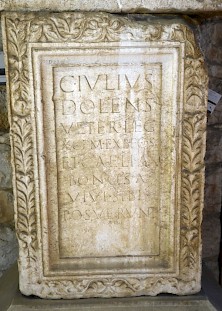
Now that the frontier zone was improved, the Romans could transfer military units, and in 103, the Tenth Legion was first moved to Aquincum (modern Budapest) in Pannonia, only to be transferred to Vindobona (Vienna) after the war (in 114?). In both towns, X Gemina had to defend the Danube frontier. Both towns belonged to the province of Pannonia. These movements must have had something to do with Trajan's Second Dacian war (105-106), but there is still no evidence for active involvement, although one inscription suggests that the Tenth was part of a task force with I Minervia and VI Victrix from Bonn and Neuss.
Campaigns in the north and east
During the reign of Hadrian, a subunit was sent to Judaea to fight against the messianic claimant Simon ben Kosiba, whose rebellion lasted from 132 to 136. Similar subunits were sent to Mauretania during the reign of Antoninus Pius (138-161) and to the east to take part in the Parthian war of Lucius Verus (162). During the reign of Marcus Aurelius, the Tenth Legion fought against the Quadi. (This emperor died in the legion's city Vindobona, in 180.) A legionary base has been identified at Mušov in the Czech Republic.
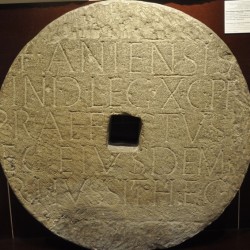 Vienna, Burial inscription of an officer of the Tenth Legion Gemina, later used in a mill. |
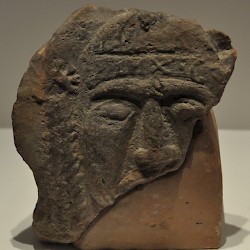 Vienna, Head of a man with inscription X Gemina |
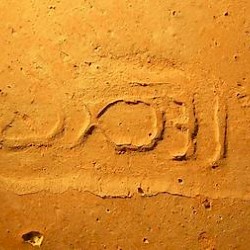 Vienna, Tile of X Gemina Severiana |
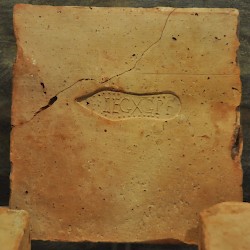 Mušov, Tile of X Gemina |
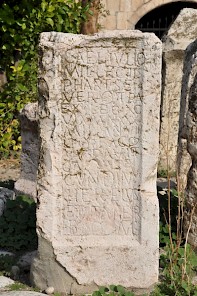
In the civil war after the assassination of the emperor Publius Helvius Pertinax in 193, the legion sided with the governor of Pannonia Superior, Lucius Septimius Severus. It seems that a subunit was sent to the east to take part in his wars against his rival Pescennius Niger and the Parthians, but the inscription that is used to prove this activity (from Ankara) may refer to another Parthian war.
During the reign of Severus, several soldiers of the Tenth Legion were transferred to the imperial guard in Rome. An inscription in Apamea (Syria) seems to document a transfer of a soldier of X Gemina to the newly-created legion II Parthica, which also stayed in Rome and (like the imperial guard) accompagnied the emperor when he went to the front.
In the third century, the Tenth received several surnames, which suggest its loyalty to the emperors Caracalla or Heliogabalus (211-217 or 218-222; Antoniniana), Gordian III (238-244; Gordiana), Decius (249-251; Deciana), Florianus (276; Floriana), and Carinus (283-285; Cariniana). From this set of rulers, Caracalla, Decius, and Carinus waged Germanic wars. Gordian III is known for a war against the Sasanian dynasty in Persia, and may have used a subunit of X Gemina. Why Florian, who ruled for a mere 88 days and never left Asia Minor, would award an honorific to a unit that was stationed on the banks of the Danube, is unknown.
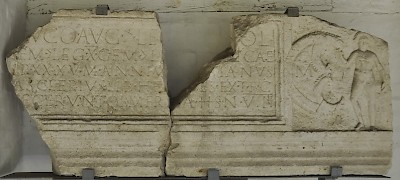
In 235-238, X Gemina may - like neighboring units - have taken part in the emperor Maximinus' wars in Dacia and southern Germania. However, evidence is completely lacking, and perhaps it is no coincidence that we do not know about a surname Maximiniana. During the conflict between the emperor Gallienus (260-268) and his rival Postumus of the Gallic Empire, the legion certainly supported the first-mentioned, for which it was rewarded with surnames like Pia VI Fidelis VI ("six times faithful and loyal"). This proves that it was awarded the titles Pia II Fidelis II to Pia V Fidelis V in the 164 years between Domitian and Gallienus, but we have no idea when this happened.
The Tenth, "twin" Legion was still in Vienna in the early fifth century. Like almost all Caesarian legions, the emblem of this legion was a bull.
Literature
- J. Gómez-Pantoja, "Legio X Gemina", in: Yann Le Bohec, Les légions de Rome sous le Haut-Empire (2000 Lyon) 169-190
- J.K. Haalebos, "Römische Truppen in Nijmegen", in: Yann Le Bohec, Les légions de Rome sous le Haut-Empire (2000 Lyon) 465-489
- M.C.J. Miller, "Legio Decima Equitata. The Tenth Legion after Caesar and the colonists of Patrae", in Ancient World 2 (1979) 139-144
- A. Morillo Cerdán & V. Garcia Marcos, "Nuevos testimonios acerca de las legiones VI Victrix y X Gemina en la region septentrional de la península Ibérica", in: Yann Le Bohec, Les légions de Rome sous le Haut-Empire (2000 Lyon) 589-607
- I. Piso, "Les légions dans la province de Dacie", in: Yann Le Bohec, Les légions de Rome sous le Haut-Empire (2000 Lyon) 205-225